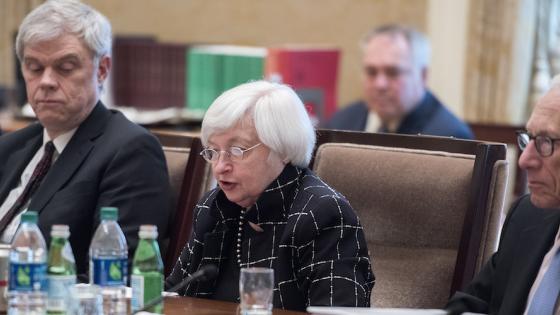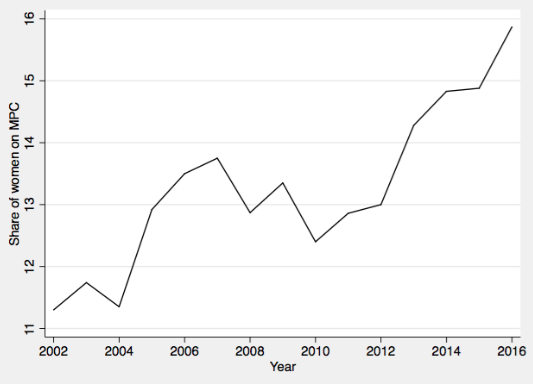Women are increasingly represented in central banks. As of June 2018, 13 central banks were headed by women, either on an interim or full-time basis, the most well-known being Elvira Nabiulina in Russia and Karnit Flug in Israel, not to mention the experience of Janet Yellen in the US. However, little is known about the evolution and role of women on monetary policy committees around the world.
Why is it so important to understand this phenomenon of underrepresentation of women on central bank boards? One possible answer lies in the relationship between gender and risk aversion, which may have implications for the conduct of monetary policy.
The composition of monetary policy committees
The literature on monetary policy committees has so far focused on investigating how the composition of central bank committees can shape monetary policy outcomes, in particular the degree of activism, i.e. their levels of dovishness/hawkishness.
The composition of these committees, including their level of diversity, seems to matter. Using an experimental approach, Blinder(2007) and Blinder and Morgan (2005, 2008) argue that committees can take more efficient monetary policy decisions via heterogeneity and diversity. Besley et al. (2008), Hix et al. (2010), and Eijffinger et al. (2018) claim that heterogeneity can even trigger regularities in monetary policy actions, making it theoretically possible to alter a board’s composition in order to drive future monetary policy decisions.
But if heterogeneity matters, then what personal characteristics are important in monetary policymaking? Chappell Jr. and McGregor (2000) were among the first to draw the attention to gender. They study the voting behaviour of Federal Open Market Committee (FOMC) members over the 1966-1996 period, ranking their dovishness/hawkishness attitude. Out of the seven women that have served on the board during that period, six of them are ranked among the 13 most dovish members. Bennani et al.(2018) look at the Fed’s monetary policy decisions over the period 1994-2008 and find that, during the 121 meetings considered, female members appeared to have a high dissenting attitude. However, these recentfindings on the role of gender in monetary policy are either limited to a single central bank or link inflation outcomes to board characteristics.
Women on monetary policy committees around the world
In a recent paper (Masciandaro et al. 2018),we construct a new dataset on the presence of women on central bank monetary policy committees for 103 countries, over the period 2002-2016. Building a comprehensive dataset on the composition of central bank boards is a challenging task. Central banks’ directories are not available online and, most of the time, they only provide the name of the board members, without explicitly identifying their gender. Thus, individual name searches need to be manually performed.
This new dataset allows us to provide a complete picture of the gender composition of central bank boards across time. Figure 1 provides a first glimpse of the data, and shows the geographical distribution of the analysed countries and the share of women on monetary policy committees in 2016.
Figure 1 Share of women on monetary policy committees in 2016
Source: Masciandaro et al. (2018)
We find that in around 20% of the countries considered, monetary policy committees have never included a woman.There is, however, high heterogeneity across countries: the average share of women on the board is 14%, with a maximum of 60% in Canada, Sweden, Serbia, and Bulgaria.
Figure 2 looks at the evolution of the share of women on monetary policy committees across time. There is an overall increasing trend in the average share of women on board, moving from 11% in 2002 to 16% in 2016. This increase has been more pronounced after 2012. Moreover, this trend is not associated with an increase in the average size of the board, which remained almost unchanged at around seven members over the analysed period. Similarly, the proportion of women that held the function of governor or deputy governor has also seen a steady increase, from less than 9% to around 16%. If we focus on women governors, in particular, this proportion has been stable until 2012 and substantially increased afterwards.
Figure 2 The average share of women on monetary policy committees, 2002-2016
Source: Masciandaro et al. (2018)
Given this heterogeneous distribution of women’s participation in central banks board, we then investigate what characteristics are associated with higher involvement of women. We find little evidence of countries’ characteristics, such as the gender equality index, income levels, or legal origins, to be associated with the presence of female members on the board.However, we do find evidence that the gender staff ratio of the central bank is associated with a higher presence of female board members.
Do women matter in monetary policymaking?
Does this increasing presence of women matter for monetary policymaking? To isolate the effects of gender heterogeneity on policy decisions, we estimate a forward-looking Taylor rule that relates the target policy rate to deviations of expected inflation and output, and we augment it to include the share of women board members and its interaction with the inflation rate. Our results show that, for the same level of inflation, a higher share of women on the central bank board is associated with a higher interest rate. In terms of magnitude, an increase of one percentage point in inflation results in an interest rate that is 30 basis points higher in a central bank with a 50% share of women members compared to the rate with a 10% share of women. This suggests that women in central banks have a more hawkish attitude, i.e. they are more aggressive in fighting inflation.
We confirm this cross-country result in a more granular analysis, where we look at the voting behaviour of members of the executive board of the Sverige Riksbank during the period 2000-2017. A detailed analysis of the voting behaviour of each member of the Riksbank’s Executive Board confirms that, in each meeting, women were more likely than men to propose a change towards a higher interest rate.
Women do matter in monetary policymaking
Our paper provides a novel contribution to the view that the composition of monetary policy boards and, more specifically, its heterogeneity, can have important implications for policymaking. We add to this debate by providing the first cross-country evidence on the impact of women board members on monetary policymaking. Although potential endogeneity concerns are not as problematic as in other policymaking areas, the robustness of our results across both fixed effects ordinary least squaresand generalised method of moments estimates weakens any possible concern. On top of that, our results appear to closely reflect the general literature on women’s representation on corporate boards, i.e. that women are more risk-averse than men are, and take more conservative decisions.
References
Bennani, H, E Farvaque and P Stanek (2018), “Influence of regional cycles and personal background on FOMC members’ preferences and disagreement”, Economic Modelling 68: 416–424.
Besley, T, N Meads and P Surico (2008), “Insiders versus outsiders in monetary policy- making”, American Economic Review 98(2): 218–23.
Blinder, A S (2007), “Monetary policy by committee: Why and how?”, European Journal of Political Economy 23(1):106–123.
Blinder, A S and J Morgan (2005), “Are two heads better than one? Monetary policy by committee”, Journal of Money, Credit and Banking: 789–811.
Blinder, A S and J Morgan (2008), “Do monetary policy committees need leaders? A reportonanexperiment”, American Economic Review 98(2):224–29.
Chappell Jr, H W and R R McGregor (2000), “A long history of FOMC voting behavior”, Southern Economic Journal: 906–922.
Eijffinger, S, R Mahieu, and L Raes (2018), “Inferring hawks and doves from voting records”, European Journal of Political Economy 51: 107–120.
Hix, S, B Høyland, and N Vivyan (2010), “From doves to hawks: A spatial analysis of voting in the monetary policy committee of the bank of England”, European Journal of Political Research 49 (6): 731–758.
Masciandaro, D, P, Profeta, and D, Romelli (2018), “Do women matter in monetary policymaking?”, BAFFI CAREFIN Centre Research Paper(2018-88).







